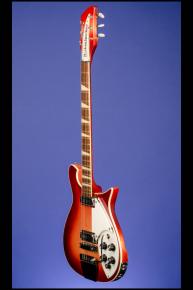An Exceptionally Fine All Original 1965 Rickenbacker 625.
1965 Rickenbacker 625 Stereo "Rick-O-Sound".
This exceptionally fine thirteen-inch-wide solid-body with a double-cutaway 'cresting-wave' shape weighs just 7.30 lbs. Two-piece solid maple body with neck-through-body construction. One-piece maple neck with a nut width of just under 1 5/8 inches, a scale length of 24 3/4 inches and a very comfortable medium profile. Rosewood fretboard with 21 original medium-to-thin frets and triangular 'crushed' pearl (extending across fretboard) markers. Serial number "EG 19 9" stamped onto jack input(s) assembly. Headstock with opaque white plastic, crescent-shaped plate lettered in white "Rickenbacker" and secured with three screws. Individual Van Ghent closed-back tuners with kidney-bean shaped pearloid buttons. Two Rickenbacker height adjustable "toaster" single-coil pickups with chrome covers and outputs of 7.80k and 8.04k. Split-level two-piece white opaque plastic pickguard with four screws. Five controls (two volume, two tone, and one blend control) plus three-way selector switch all on pickguard. The potentiometers are stamped stamped "137 6517" (CTS, April 1965). Seven-sided black plastic knobs with metal tops. Rickenbacker individually adjustable six-saddle bridge with four height-adjustment screws which in turn sits on a Rickenbacker metal plate which is secured by two screws. Rickenbacker Ac'cent Vibrato tailpiece. Two side-mounted jack inputs, one 'normal' and one Rick-O-Sound Stereo. Inside the control cavity, written in red pencil is "625-T". This fine guitar is in exceptionally fine (9.00+) condition with just the bare minimum of belt-buckle scarring on the back and a few tiny surface marks on the edges - certainly the best example of a 625 that we have ever seen. Housed in the original Rickenbacker three-latch, rectangular Silver-Gray case with black leather ends and blue plush lining (9.00).
According to Richard Smith a total of just 229 Fireglo Model 325's were shipped between 1962 and 1968 - 62 in 1962; 70 in 1963; 35 in 1964; 61 in 1965 and 1 in 1968.
"… and a new stereo output feature called Rick-O-Sound was added to some guitars, usually the 'deluxe' models from around the summer of that year [1960]. Rick-O-Sound exploited the new interest at the time in stereophonic sound, consolidated in 1958 when most of the big recording companies began issuing stereo records. At this time Gretsch and then Gibson launched 'stereo' guitars, and Rickenbacker decided to follow suit. The company's system simply separated the output from the neck and bridge pickups so that a special split cord would feed the individual signals to two amplifiers (or to two channels of one amplifier). This pseudo-stereo feature was made possible by a special double jack socket plate fitted to Rick-O-Sound-equipped Rickenbackers. One socket was marked 'Standard': when an ordinary mono jack plug was inserted here, a switch contact inside disconnected the stereo circuit and provided normal guitar output. The 'Rick-O-Sound' socket required a stereo plug connected to a 'Y' cord. Rickenbacker offered this as an accessory with an interconnection box, rather grandly called the Rick-O-Sound Kit for $24.50 (it first appeared on the July 1960 pricelist)…
The fifth 'blend' knob is much misunderstood by guitarists, and it must be said that its effect can be very subtle. Consider the usual control set-up for a two-pickup guitar: there are individual volume and tone controls for each pickup, and a selector switch. The three-way selector offers either: (1) the pickup nearest the neck, with a more bassy tone often used for rhythm playing; (2) both pickups, balanced by the relative positions of the two volume controls; or (3) the pickup nearest the bridge, with a more treble tone for lead playing. Rickenbacker uses this control system too, but from 1961 started to add the fifth knob to many models.
The theory is that in the neck-pickup-only or bridge-pickup-only position on the three-way selector, the fifth knob gives the opportunity to blend in some tone from the unselected pickup. For example, if you had the bassier neck pickup selected, the fifth knob would allow you effectively to blend in a little of the bridge pickup’s treble tone.
If the selector is in the middle position – in other words, giving both pickups – then the fifth knob allows you to vary the precise balance between the two, for increased tonal emphasis. In fact, the later development of modern channel-switching amplifiers made the fifth knob redundant, but at the time it did seem to Rickenbacker to offer some increased versatility to the available tones.
On Rickenbackers fitted with the Rick-O-Sound stereo feature, the fifth knob functions more as a balance control between left and right (i.e. neck pickup and bridge pickup), because the selector would usually be lodged in the center position so that both pickups are ‘on.’
Confused? You are not alone. Musicians have generally found the fifth ‘blend’ knob rather baffling, and no doubt many quickly decided to forget that their guitar had a fifth knob. Beatle George Harrison sounded as exasperated as many when he spoke of his confusion: “That tiny little knob never seemed to do anything,” he told BBC Radio 1 in 1987. “All it ever seemed to be was that there was one sound that I could get where it was bright, which was the sound I used, and another tone where it all went muffled, which I never used.” Tony Bacon & Paul Day. The Rickenbacker Book (p.32,33).












